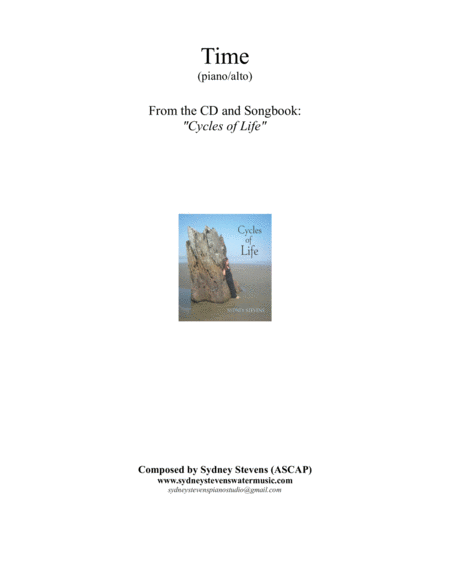Alto Voice,Vocal Solo - Level 3 - Digital Download SKU: A0.859661 Composed by Sydney Stevens. Country,Folk,New Age,Pop. 5 pages. Sydney Stevens, Water Music #2942895. Published by Sydney Stevens, Water Music (A0.859661). Contact: sydneystevenspianostudio@gmail.comTime: Peaceful piano/vocal composed by Sydney Stevens (ASCAP). Sheet music arrangement is for piano/vocal/chords.Sounds like: Sarah McLachlan, Vanessa Carlton, Loreena McKennittFrom Album: Cycles of Life Theme: Contemplative theme of time passing more quickly the longer we're here -- the hourglass effect. Also, how time seems to pass faster when we are doing something we love.Mood: Romantic, gentle, warm, emotional.Musical Traits: Strong melody in right hand piano that reflects the vocal line.Performance Time: 4:17Sydney Stevens music is available on: Pandora, Spotify, iTunes, Amazon, Whisperings Solo Piano Radio, AllMusicMore Links: www.sydneystevenswatermusic.com http://www.linkedin.com/in/sydney-stevens-532a113aBIOGRAPHY:Sydney Stevens began writing melodies on the piano before she could reach the pedals. Her earliest memory was watching her mother play classical piano. She began piano lessons at the age of 8, and started composing shortly thereafter.Stevens approaches her compositions as an artist. She paints musical portraits of the things that bring meaning to life: relationship to living things, emotional healing, discovering what matters most and honoring that as best we are able. Stevens' beautiful piano-based music aligns one with their own heart. Although some of her music can be described as New Age, her roots are heavily based in classical and jazz. Her study of classical composition makes her music more complex than some New Age music. Her music has been likened to the impressionistic composers such as Claude Debussy. Sydney's formal training is also reflected in her ability to compose for orchestral instruments. Her latest release, Cycles of Life, was solely recorded and produced by Sydney, programming all of the virtual instruments.Sydney has a great love for jazz. Keith Jarrett was an influence on her with his innovative and improvisational piano recordings and performances. She was particularly impressed with the freedom of style he portrayed in his performances. Bill Evans was something Sydney heard played as a young child. Where her mother was a classical pianist, her father was a jazz pianist. Perhaps that's why some of Sydneyâs music can be described as a crossover between classical and jazz--remnants from those early years. Joni Mitchell and Judy Collins were big inspirations for Sydney's songwriting. She was especially drawn to the deeply emotional lyrics in many of their songs.Cycles of Life, the title track from Sydney's current release, was composed for her late step dad. The song is about the cycle of birth and death: Cycles of life go on, yet we carry all that we've known and loved through the ages. Time, another track on Sydney's current release, is a song about how time passes more quickly when we are doing something we cherish. Brian's Song, inspired by the loss of her father-in-law, reflects: All that really matters is the way we fill our heart, and the ways that it has loved. Dawn, a track from Sydney's album Seasons, is a beautiful piano-based instrumental with light string background. It portrays that very peaceful hour as the sun slowly lights up the world -- the hour of dawn.Sydney is a poet. She sees the world through a heart that feels the joy and sorrow of the world and those she meets. Her gift is the ability to transfer that emotion into music. Listening to her music is like taking a journey. She delves into depths of emotion, often taking the lis.
